Getting to know the National Flag, National Emblem, National Anthem, Regional Flag and Regional Emblem
1. Brief descriptions of the National Flag
2. Brief descriptions of the National Emblem
3. Brief descriptions of the National Anthem
4. Brief descriptions of the Regional Flag of Hong Kong SAR
5. Brief descriptions of the Regional Emblem of Hong Kong SAR
6. Display of the Flags and Emblems
7. Learning and teaching resources
1. Brief descriptions of the National Flag
- The Preparatory Committee of the New Political Consultative Conference decided to set up a first-round selection committee on the designs of the national flag and national emblem on 16 June 1949 and invited submission of designs through such newspapers as the People’s Daily between 14 July and 15 August of the same year. Subsequently, the first-round selection committee selected 38 designs from a total of 3 012 received and turned them into print for discussion at the First Plenary Session of the Chinese People’s Political Consultative Conference in September 1949. A resolution adopting the “Five-star Red Flag” as the national flag was passed on 27 September 1949.
| The National flag 
The National Flag of the People's Republic of China |
- The red colour of the national flag of the People’s Republic of China symbolises revolution. The five five-pointed stars and their relationship represent the unity of revolutionaries under the leadership of the Communist Party of China. In bright yellow, these five-pointed stars look lustrous and “radiate” from the red land. The four smaller five-pointed stars each has one tip pointing to the centre of the bigger star. The compact and pleasant layout signifies unity around a centre.
- On 1 October 1949, the national flag of the People’s Republic of China was raised for the first time at Tiananmen Square in Beijing.
Specifications for the National Flag
- The shape and colour of either side of the national flag shall be identical, whereas the five stars on both sides of the flag shall be opposite to each other. At this site, these specifications shall take the circumstances where the staff is on the left as the basis for illustration.
- The face of the flag shall be red and rectangular; the proportions of its length and height shall be 3 to 2. The upper left of the face of the flag shall be studded with five yellow five-pointed stars. One of the stars shall be bigger than the others, with its circumcircle's diameter being 3/10ths of the height of the flag, and shall be placed in the left; the four other stars shall be smaller, with their circumcircle's diameter being 1/10th of the height of the flag, encircling the big star on its right in the shape of an arc. The cover of the staff shall be white.
- The five stars shall be positioned and drawn as follows:
- To determine the position of the five stars, the face of the flag shall be first folded both ways to form four equal rectangles; then the rectangle on the upper left shall be vertically divided into 10 equal sections and horizontally divided into 15.
- The central point of the big five-pointed star shall be at a point in the rectangle where the 5th line from above (or the 5th line from below), and the 5th line from the left (or the 10th line from the right) meet. The method of drawing shall be: taking this point as the centre and the length of three such equals as the radius to make a circle. On the circumference of this circle, five points with equal distances from each other shall be determined, one of the points must be in the right above position of the circle. Then connect each of the five points with every other point to form a straight line respectively. The outline formed by these five straight lines shall be the required big five-pointed star. An angle of the five-pointed star shall point in the right above direction.
- The centres of the four small five-pointed stars shall be as follows: the first shall be at a point, in the rectangle, where the 2nd line from above (or the 8th line from below), and the 10th line from the left (or the 5th line from the right) meet; the second shall be at a point where the 4th line from above (or the 6th line from below), and the 12th line from the left (or the 3rd line from the right) meet; the third shall be at a point where the 7th line from above (or the 3rd line from below), and the 12th line from the left (or the 3rd line from the right) meet; the fourth shall be at a point where the 9th line from above (or the 1st line from below), and the 10th line from the left (or the 5th line from the right) meet. The method for drawing shall be: taking each of the above four points as the centre and the length of one such equal as the radius to make four circles. On each circle, five points with equal distances from each other shall be determined. One of such points must be on the line linking the centre of the circle with the centre of the big five-pointed star. Then the same methods used in forming the big five-pointed star shall be used to form the small five-pointed stars. The four small five-pointed stars shall respectively have an angle pointing right at the centre of the big five-pointed star.
Standard sizes of the National Flag
The measurement in common use for the national flag, from which people from various circles may choose at their discretion shall be as follows:
Length (cm) | Height (cm) |
288 | 192 |
240 | 160 |
192 | 128 |
144 | 96 |
96 | 64 |
If national flags of nonstandard sizes are required in special circumstances, they are to be of a scaled-up or a scaled-down size. The size of the national flag must be proportional to the staff, and be commensurate with the purpose of use, the surrounding buildings and the surrounding environment.
Download area for the National Flag
For other details of the specifications for the national flag, please refer to Schedule 1 of the National Flag and National Emblem Ordinance (on the website of Hong Kong e-Legislation).
Reference:
- The Constitution of the People’s Republic of China
- The National Flag and National Emblem Ordinance
- The State Council, the People’s Republic of China – National Flag
- The Protocol Division, Government Secretariat
Back to the top
2. Brief descriptions of the National Emblem
- On 18 June 1950, the Second Session of the First National Committee of the Chinese People’s Political Consultative Conference passed the Design and Description of the National Emblem of the People's Republic of China. On 20 September of the same year, Chairman MAO Zedong of the Central People's Government made official the national emblem of the People's Republic of China.
| The National Emblem 
The National Emblem of the People's Republic of China |
- In 1954, a stipulation regarding the design of the national emblem was formally included in the Constitution of the People’s Republic of China. The national emblem consists of an image of Tian'anmen in its centre illuminated by five stars and encircled by ears of grain and a cogwheel. The stipulation has been in place since then.
- On 2 March 1991, the Eighteenth Session of the Standing Committee of the Seventh National People's Congress passed the “National Emblem Law of the People's Republic of China” so as to preserve the dignity of the national emblem, ensure the correct use of the national emblem, and lay down specific requirements on the use of the national emblem.
- The national emblem of the People's Republic of China consists of a national flag, Tian'anmen, a cogwheel and wheat and rice stems and heads, symbolizing the birth of New China under people's democratic dictatorship which is led by the working class and based on the alliance of workers and peasants through the Chinese people's new-democratic revolutionary struggle ever since the May Fourth Movement.
Specifications for the National Emblem
- Two bunches of wheat and rice form a round ring. A cogwheel is placed where the wheat and rice stems cross at the base. Red ribbon forms a knot in the centre of the cogwheel. The red ribbon coils up the wheat and rice on the left and right of the cogwheel and hangs down, dividing the cogwheel into an upper and a lower part.
- If a vertical straight line is drawn in the centre of the design, the left and right parts are completely symmetrical.
- The national emblem is in red and gold: the wheat and rice, the five stars, Tian'anmen and the cogwheel are in gold, the base of the part within the round ring and the hanging ribbon are in red; the red is the same as the national flag; the gold is pure gold (light and bright).
Standard sizes of the National Emblem
The diameters of the usual dimensions of the national emblem for display or use are as follows:
(1) 100 cm
(2) 80 cm
(3) 60 cm
If national emblems of nonstandard sizes are required in special circumstances, they are to be of a scaled-up or a scaled-down size, and be commensurate with the purpose of use, the buildings where they are hung and the surrounding environment.
Download Area for the National Emblem
For other details of the specifications for the national emblem, please refer to Schedule 2 of the National Flag and National Emblem Ordinance (on the website of Hong Kong e-Legislation).
Reference:
- The Constitution of the People's Republic of China
- The National Flag and National Emblem Ordinance
- The Central People's Government, the People's Republic of China – National Emblem
- The Protocol Division, Government Secretariat
Back to the top
3. Brief descriptions of the National Anthem
History of the National Anthem
“March of the Volunteers” is the national anthem of the People’s Republic of China. It was originally the theme song of Sons and Daughters in a Time of Storm (1935), a movie about fighting against Japan Aggression and saving the country. The song was written by the noted poet Tian Han with music by the famous composer Nie Er (see note). The original story of Sons and Daughters in a Time of Storm was created by Tian. It depicts the heroic stories of young people marching to the front line to defend their country against Japanese occupation in the early 1930s.
The 1930s, which unveiled the War of Resistance Against Japanese Aggression in the history of modern China, threw the entire Chinese nation into a life-and-death situation. On 18 September 1931, induced by the Japanese militarism, the Japanese Imperial Army launched an outrageous attack and occupied northeast China. This attack, which is later called the “Mukden Incident” provoked the strong resistance of the Chinese people. There were different sorts of campaigns against Japanese Aggression everywhere to call upon people to save the country. Tian Han and Nie Er's "March of the Volunteers" was one of the songs to propagate the message of anti-aggression. With its strong regular rhythm and uplifting tune, the song captures the fearless and tenacious fighting spirit of the Chinese nation.
“March of the Volunteers” circulated extensively throughout the country after the movie Sons and Daughters in a Time of Storm premiered in May 1935. On 27 September 1949, the First Plenary Session of the Chinese People's Political Consultative Conference decided: Before the national anthem of the People's Republic of China was formally formulated, "The March of Volunteers" composed by Tian Han and Nie Er was adopted as the provisional national anthem. On 1 October 1949, the Central People's Government of the People's Republic of China was established. At Tiananmen Square in Beijing, with the rise of the “Five-star Red Flag”, "March of the Volunteers" resonated for the first time at Tiananmen Square.
On 14 March 2004, the Tenth National People's Congress passed the "Constitution (Amendment)" and added a paragraph to Article 136 of the Constitution of the People's Republic of China, stipulating that "March of the Volunteers” shall be the national anthem of the People's Republic of China.
On 1 September 2017, the Twenty-ninth Session of the Standing Committee of the Twelfth National People's Congress passed the “National Anthem Law of the People's Republic of China”, which took effect in the country from 1 October 2017. On 4 November 2017, the Thirtieth Session of the Standing Committee of the Twelfth National People's Congress agreed to add the "National Anthem Law of the People's Republic of China" to Annex III to the Basic Law of the Hong Kong Special Administrative Region of the People's Republic of China. In parallel, the Hong Kong Special Administrative Region (HKSAR) Government announced that, pursuant to Article 18 of the Basic Law, the "National Anthem Law of the People's Republic of China" would be implemented in the HKSAR by way of local legislation consistent with the constitutional and legal regime of the HKSAR. On 4 June 2020, the National Anthem Bill was passed at Third Reading by the Legislative Council. On 11 June 2020, the Chief Executive signed the National Anthem Ordinance in accordance with Article 48(1)(3) of the Basic Law. The National Anthem Ordinance came into immediate effect on the next day, 12 June after it was being gazetted.
Note:
Music: Nie Er (1912-1935), formerly known as Nie Shouxin, was born in Kunming, Yunnan. As a teenager, he already showed a keen interest in music. He moved to Shanghai and wrote "March of the Volunteers".
Lyrics: Tian Han (1898-1968), also named Shouchang, was born in Changsha, Hunan. He was a pioneer in modern drama and opera reform movement of China. He once studied in Japan.
Official audio tracks of the National Anthem
Lyrics of the National Anthem (Chinese only, with English translation)
| Official Chinese Lyrics | | English Translation* |
中華人民共和國國歌
《義勇軍進行曲》 | | National Anthem of the People’s Republic of China
March of the Volunteers |
田漢作詞
聶耳作曲 | | Lyrics By Tien Han
Composed by Nie Er |
起來!
不願做奴隸的人們!
把我們的血肉,
築成我們新的長城!
中華民族到了最危險的時候,
每個人被迫着發出最後的吼聲。
起來!
起來!
起來!
我們萬眾一心,
冒着敵人的炮火,
前進!
冒着敵人的炮火,
前進!
前進!
前進!進! | | Arise,
We who refuse to be slaves!
With our very flesh and blood,
Let us build our new Great Wall!
The peoples of China are at their most critical time,
Everybody must roar defiance.
Arise,
Arise,
Arise,
Millions of hearts with one mind,
Brave the enemy’s gunfire,
March On!
Brave the enemy’s gunfire,
March On!
March On!
March On! |
- The content of the lyrics which reflects that the country was in a grim situation. For example, the lines “Arise, we who refuse to be slaves!” and “Brave the enemy’s gunfire” imply that the nation was at war, while “The peoples of China are at their most critical time” and “Everybody must roar defiance” suggest that the nation was struggling for survival.
Musical features
“March of the Volunteers” is a march. The trumpet introduction imitates the sound of the bugle giving a strong sense of rhythm. Its musical features include:
- a march in G major in duple time.
- syllabic setting of the lyrics based on the rhythmic features of the song which creates an energetic mood.
- the use of triplets in the introduction and the latter half of the song to enhance the expressiveness of the music.
Standard and etiquette for playing and singing the National Anthem
Section 3 of the National Anthem Ordinance stipulates that the national anthem must be played and sung in a way that is in keeping with its dignity. While the national anthem is being played and sung, the etiquette to be followed by the persons who take part in or attend the occasion is—
(a) to stand solemnly and deport themselves with dignity; and
(b) to not behave in a way disrespectful to the national anthem.
Standard score
Under section 5 of the National Anthem Ordinance, a reference to the national anthem being played and sung is a reference to the national anthem being played on musical instruments in accordance with the standard score, or an official recording of the national anthem being played, for the singing of the national anthem. The standard performance scores of the national anthem are as follows:
Standard performance scores
Reference:
1. The State Council, the People’s Republic of China – National Anthem
2. Constitutional and Mainland Affairs Bureau, the Government of the Hong Kong Special Administrative Region of the People’s Republic of China, – National Anthem
Back to the Top
4. Brief descriptions of the Regional Flag of the Hong Kong SAR
- “Regional flag” means the regional flag of the Hong Kong Special Administrative Region endorsed at the Fourth Plenum of the Preparatory Committee of the Hong Kong Special Administrative Region on 10 August 1996.
| The Regional Flag 
The Regional Flag of the Hong Kong Special Administrative Region |
- The collection and selection of designs for the regional flag and regional emblem of the Hong Kong Special Administrative Region were the responsibility of the Committee for Selecting Designs for the Regional Flag and Regional Emblem of the Hong Kong Special Administrative Region, consisting of five drafters of the Basic Law and six experts from both Hong Kong and the Mainland. After the selecting committee conducted the first and second rounds of selection from the 7 147 contributed designs, the Basic Law Drafting Committee examined and appraised the candidates recommended by the selecting committee. Since the Drafting Committee failed to decide upon a single set of designs for the regional flag and regional emblem to be submitted to the National People’s Congress for examination, the selecting committee again worked out three sets of candidate designs of the regional flag and regional emblem for the Hong Kong Special Administrative Region through collective modification of certain contributed designs. The draft designs of the regional flag and regional emblem to be submitted to the National People’s Congress for examination were finally selected at the ninth plenary session of the Basic Law Drafting Committee through secret ballot. On 4 April 1990, a resolution regarding the designs of the regional flag and regional emblem of the Hong Kong Special Administrative Region was passed at the Third Session of the Seventh National People’s Congress.
- The regional flag carries a design of five bauhinia petals, each with a star in the middle, on a red background. The red flag represents the motherland and the bauhinia represents Hong Kong. The design implies that Hong Kong is an inalienable part of China and prospers in the embrace of the motherland. The five stars on the flower symbolise the fact that all Hong Kong compatriots love their motherland, while the red and white colours embody the principle of “One Country, Two Systems”.
- On 1 July 1997, the regional flag of the Hong Kong Special Administrative Region was raised for the first time at the Hong Kong Convention and Exhibition Centre in Wan Chai.
Specifications for the Regional Flag of the Hong Kong SAR
- The shape and colour on both sides of the regional flag are identical. The bauhinia design on both sides are identical. At this site, only the specifications for the regional flag with the pole standing on its left are listed below.
- The regional flag is in red, which is identical with that of the national flag of the People's Republic of China. The regional flag is rectangular in shape with its length/height ratio being 3 to 2. At the centre of the regional flag is a white 5-petal bauhinia in swaying motion. The diameter of its outer circle is 3/5 of the regional flag's height. The petals are evenly arranged round the central point of the regional flag in a clockwise direction. Each petal bears a red 5-pointed star and a red style. The centre of the bauhinia lies on the central point of the regional flag. The case of the pole is in white.
Standard sizes of the Regional Flag of the Hong Kong SAR
There are eight different standard sizes of the regional flag. Their measurements are as follows:
| Length (cm) | Height (cm) |
Number 1 | 288 | 192 |
Number 2 | 240 | 160 |
Number 3 | 192 | 128 |
Number 4 | 144 | 96 |
Number 5 | 96 | 64 |
Car Flag | 30 | 20 |
Flag for Signing Ceremony | 21 | 14 |
Desk Flag | 15 | 10 |
If regional flags of non-standard sizes are required to meet special needs, they shall be of a scaled-up or a scaled-down size.
Download area for the Regional Flag of the Hong Kong SAR
For other details of the specifications for the regional flag, please refer to Schedule 1 of the Regional Flag and Regional Emblem Ordinance (on the website of Hong Kong e-Legislation).
Reference:
- The Basic Law of the Hong Kong Special Administrative Region of the People's Republic of China
- The Regional Flag and Regional Emblem Ordinance
- Explanations on “the Basic Law of the Hong Kong Special Administrative Region of the People's Republic of China (Draft)” and Its Related Documents (Addressing the Third Session of the Seventh National People's Congress” on 28 March 1990)
- “Decision of the National People's Congress on the Basic Law of the Hong Kong Special Administrative Region of the People's Republic of China” (Adopted at the Third Session of the Seventh National People's Congress on 4 April 1990)
- The Protocol Division, Government Secretariat
Back to the Top
5. Brief descriptions of the Regional Emblem of the Hong Kong SAR

Specifications for the Regional Emblem of the Hong Kong SAR
- The regional emblem of the Hong Kong SAR is round in shape. It bears a red circular edge, an outer ring marked with scripts, a red inner ring with a design of a swaying bauhinia with 5 star-shaped stamens.
- The swaying bauhinia design at the centre of the inner ring of the regional emblem is white in colour. It is formed by 5 petals, each with a red 5-pointed star and a red style. The petals are evenly arranged around the central point of the regional emblem in a clockwise direction. The centre of the bauhinia lies on the central point of the regional emblem.
Standard Sizes of the Regional Emblem of the Hong Kong SAR
There are three standard sizes of the regional emblem. Their measurements are as follows:
Size 1 | 100 cm in diameter |
Size 2 | 80 cm in diameter |
Size 3 | 60 cm in diameter |
If regional emblems of non-standard sizes are required to meet special needs, they shall be of a scaled-up or a scaled-down size.
Download area for the Regional Emblem of the Hong Kong SAR
For other details of the specifications for the regional emblem, please refer to Schedule 2 of the Regional Flag and Regional Emblem Ordinance (on the website of Hong Kong e-Legislation).
Back to the Top
6. Display of the Flags and Emblems
- All individuals and organisations have the responsibility to display the national flag, national emblem, regional flag and regional emblem with dignity and respect. In this regard, this page provides some general information relating to the display of the flags and emblems with reference to the National Flag and National Emblem Ordinance, the Regional Flag and Regional Emblem Ordinance and the stipulations published by the Chief Executive, as well as the administrative guidelines of the Government of the Hong Kong Special Administrative Region (HKSAR). For other information relating to the prohibition on certain uses of the flags and emblems, please click here.
Condition of the Flags
- To safeguard the dignity of the flags, we must not display or use the flags which are damaged, defiled, faded or substandard.
- We must not display the flags upside down, and must not display or use the flags in any way that undermines the dignity of the flags.
- Flags should be regularly inspected to ensure that they are clean and in good condition. They should be dried and kept neatly folded and stored when not in use.
Raising and lowering of the Flags
- Only one flag shall be hoisted from a flag staff.
- When hoisted or lowered from a vertical staff, the flags shall be hoisted or lowered slowly. When hoisted, the flags must reach the peak of the staff. When lowered, they may not touch the ground.
- When flown together with the regional flag, the national flag shall be hoisted first and lowered last. When the flags are being raised during a flag-raising ceremony, the etiquette to be followed by the persons who take part in or attend the ceremony is to stand solemnly facing the flags; to look at the flags with respectful attention or to salute the flags in an appropriate manner (as the case requires); and to not behave in a way that undermines the dignity of the flags.
- When flown at half staff, the flags shall be first hoisted to the peak of the staff and then lowered to a point where the distance between the top of the flag and the peak of the staff is one third of the length of the staff. The flags, when lowered, shall be again hoisted to the peak before they are lowered.
- The National Flag and National Emblem Ordinance and the Regional Flag and Regional Emblem Ordinance also set out the conditions for flying the flags at half staff.
- The proper procedures for the raising and lowering of the flags should be carefully explained to the staff responsible for this duty.
Severe weather conditions
- The flags may not be hoisted or lowered in case of severe weather conditions.
Priority of the National Flag
- When the national flag is displayed, it shall be placed in a prominent position.
- When the national flag is raised or carried in a procession with another flag or flags, it shall be in front of the other flag or flags.
- When the national flag is displayed with another flag or flags, it shall be either at the centre, above the other flag or flags, or in a position of prominence.
- When the national flags of two or more nations are displayed in foreign affairs activities, relevant provisions of the Ministry of Foreign Affairs or the international practice shall be followed.
Flying the National Flag and Regional Flag at the same time
- The national flag, when displayed with the regional flag, shall be either at the centre, above the regional flag, or in a position of prominence.
- When both the national flag and regional flag are raised in a procession, the national flag is to precede the regional flag.
- When the national flag and regional flag are displayed at the same time or displayed side by side, the regional flag shall be smaller than the national flag, with the national flag on the right and the regional flag on the left.
- For the display of the national flag and regional flag inside a building, "left" and "right" sides of the backing wall are ascertained by reference to a person standing with his back to the wall and looking forward.
- For the display of the national flag and regional flag outside a building, "left" and "right" sides of the building are ascertained by reference to a person standing in front of the building and looking towards the front entrance of the building.
Recovery and disposal of the Flags and Emblems
- A national flag, national emblem, regional flag or regional emblem must not be discarded at will. A national flag, national emblem, regional flag or regional emblem that is damaged, defiled, faded or substandard must be returned to a designated collection point for central handling by the Hong Kong Special Administrative Region Government. For details of the designated collection points, please visit the website of the Home Affairs Department.
- After an event in which the national flags, national emblems, regional flags or regional emblems are used, the organizer must recover the flags or emblems used on site of the event for keeping and reuse. For the used flags or emblems that are damaged, defiled, faded, or substandard, they must be returned to the designated collection points mentioned in the above for central handling.
Display of the Flags and Emblems at Government offices and premises
- At present, the national and regional flags are displayed every day at the official residences of the Chief Executive, the Government House, the Central Government Offices, all boundary control and check points of the HKSAR, the Hong Kong International Airport and the Golden Bauhinia Square. The flags are also displayed on each working day and on the six specified days, i.e. National Day (1 October), HKSAR Establishment Day (1 July), Labour Day (1 May), New Year's Day (1 January), Lunar New Year's Day and National Constitution Day (4 December) at the office of the Chief Executive, the Executive Council, the Legislative Council, the law courts in the HKSAR, government departmental headquarters, major government composite buildings and public sports and cultural venues, etc. For a list of locations for the display of national flag and regional flag in government premises, please click here.
- The national flag and regional flag displaying at government premises should, as far as practicable, be raised at 8:00 a.m. and lowered at 6:00 p.m.
- The national emblems are displayed at the office of the Chief Executive, the Central Government Offices and the Justice Place (formerly the Central Government Offices Note). In addition, the regional emblems are displayed at the official residences of the Chief Executive, the Government House, the Executive Council, the Legislative Council, the Central Government Offices, the law courts of the HKSAR, all boundary control and check points of the HKSAR, Hong Kong International Airport, District Offices, etc.
Note For heritage conservation reason, the national emblem displayed at the former Central Government Offices has been preserved in-situ after the venue was renamed as the Justice Place.
Oath-taking ceremonies
- The oath-taking ceremonies set out in item 1 of Schedule 3 to the National Anthem Ordinance are required to display the national flag and national emblem.
According to the website of the Protocol Division, Government Secretariat, certain uses of the flags and emblems are prohibited:
- All individuals and organisations should respect and cherish the national flag, national emblem, regional flag and the regional emblem. As such, the flags and emblems which are damaged, defiled, faded or substandard must not be displayed or used. They must not be displayed upside down, and must not be displayed or used in any way that undermines their dignity. They must also be manufactured in accordance with their specifications set out in the National Flag and National Emblem Ordinance and the Regional Flag and Regional Emblem Ordinance.
- The national flag or national emblem or their designs must not be displayed or used in trademarks, registered designs or commercial advertisements, while the regional flag or regional emblem or their designs must not be displayed or used in trademarks or advertisements. In addition, the national flag or its design must not be displayed or used in private funeral activities, and the national emblem or its design must not be displayed or used in products in everyday life and furnishings or ornaments in everyday life, or private activities of celebration or condolence. It is an offence to use the flags or emblems contrary to these prohibitions.
- A person commits an offence if the person publicly and intentionally desecrates the national flag or national emblem by burning, mutilating, scrawling on, defiling or trampling on it or its image or in any other way. Furthermore, a person commits an offence if, with intent to desecrate the national flag or national emblem, the person intentionally publishes a desecration of the national flag or national emblem by burning, mutilating, scrawling on, defiling or trampling on it or its image or in any other way.
- As regards the regional flag and regional emblem, a person who desecrates the regional flag or regional emblem by publicly and wilfully burning, mutilating, scrawling on, defiling or trampling on it commits an offence.
- For details of the offence provisions, please refer to the respective Ordinances.
Applying for using the Flags and Emblems
A person shall not use the national flag, national emblem, regional flag or regional emblem or their designs in connection with any trade, calling or profession, or the logo, seal or badge of any non-governmental organisation, except with prior approval. Prior application to the Administration Wing on the use of the national flag, national emblem, regional flag or regional emblem or their designs should be made in writing to the following address:
Administration Wing, Chief Secretary for Administration's Office
25/F, Central Government Offices
2 Tim Mei Avenue, Tamar, Hong Kong
[Attn.: Executive Officer(General)2]
Tel no.: 2525 5477
Fax no.: 2804 6552
Email: flags&emblems@cso.gov.hk
Points to note on display of the national flag and regional flag, and conduct of national flag raising ceremony in schools
To promote national education and help students develop a sense of belonging to the country, an affection for the Chinese people and enhance their sense of national identity, all primary and secondary schools (including special schools) must display the national flag on each school day, as well as New Year’s Day (January 1), Hong Kong Special Administrative Region Establishment Day (July 1) and National Day (October 1). Schools should display the regional flag alongside the national flag if there are adequate flagpoles. Schools are also required to conduct a national flag raising ceremony weekly and on the above days or the preceding/following school day. The national anthem should be played and sung in a national flag raising ceremony. Schools are strongly advised to conduct a national flag raising ceremony on important days and special occasions (such as graduation ceremony, swimming gala/sports day).
As far as conditions permit, kindergartens should, having considered factors such as availability of space, facilities and environment, follow the requirements for primary and secondary schools on displaying the national flag and regional flag, and conducting a national flag raising ceremony so that students can learn about the national flag, national anthem and regional flag from an early age. International schools and other private primary, secondary schools and kindergartens offering solely non-local curricula are also encouraged to refer to the requirements for primary and secondary schools, and arrange for displaying the national flag and regional flag, and conducting a national flag raising ceremony based on the actual school circumstances, in order to enable students of different ethnicities or nationalities to learn about the culture and history of the country where they live.
(For details, please refer to the Education Bureau Circular No. 6/2024: National Flag, National Emblem, National Anthem, Regional Flag and Regional Emblem and Frequently Asked Questions on National Flag, National Emblem, National Anthem, Regional Flag and Regional Emblem)
Reference:
- Education Bureau Circular No. 6/2024: National Flag, National Emblem, National Anthem, Regional Flag and Regional Emblem
- The National Flag and National Emblem Ordinance
- The National Anthem Ordinance
- The Regional Flag and Regional Emblem Ordinance
- The Protocol Division, Government Secretariat
Back to the Top
7. Learning and teaching resources
i. Infographics Series: National Flag, National Emblem, Nation Anthem, Regional Flag and Regional Emblem
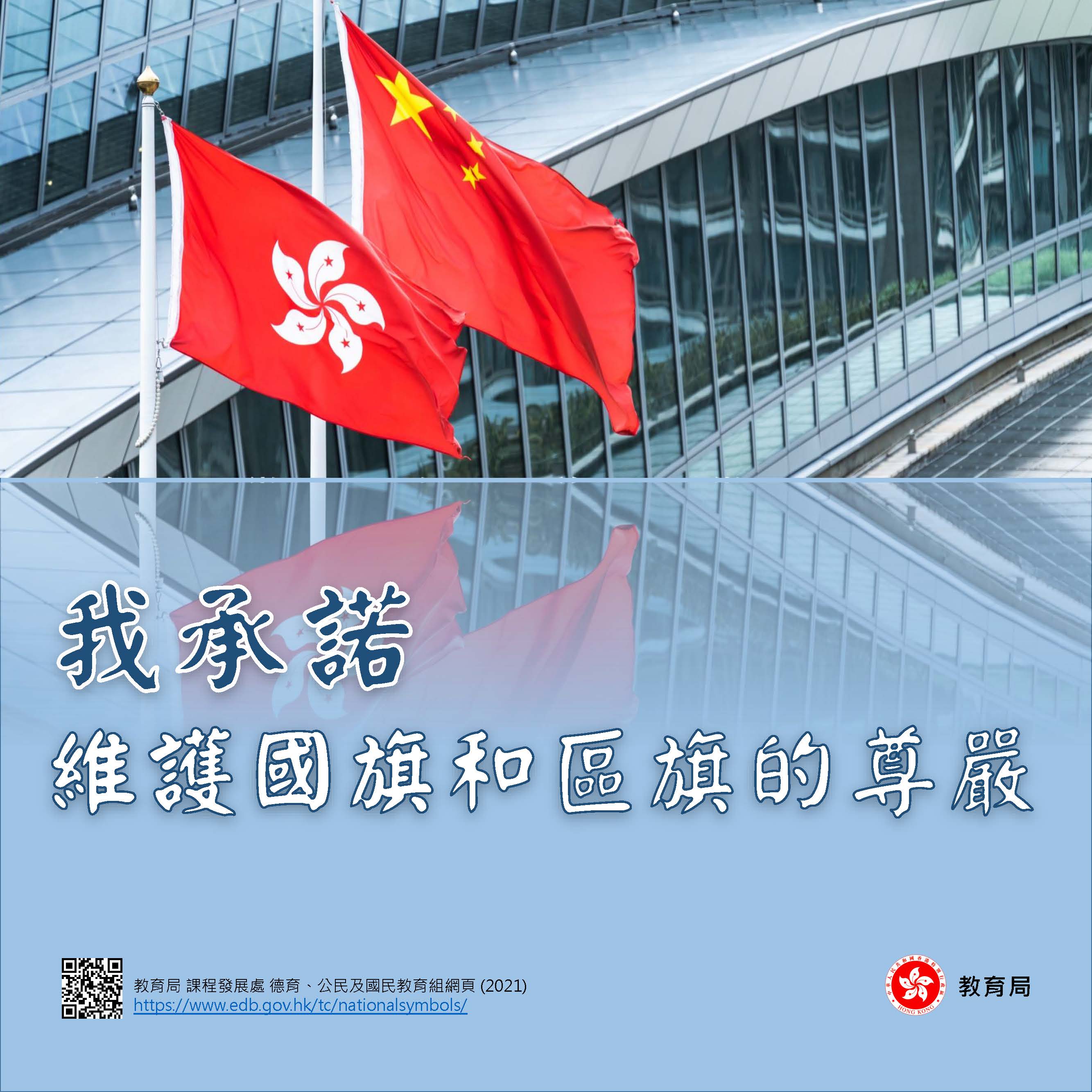
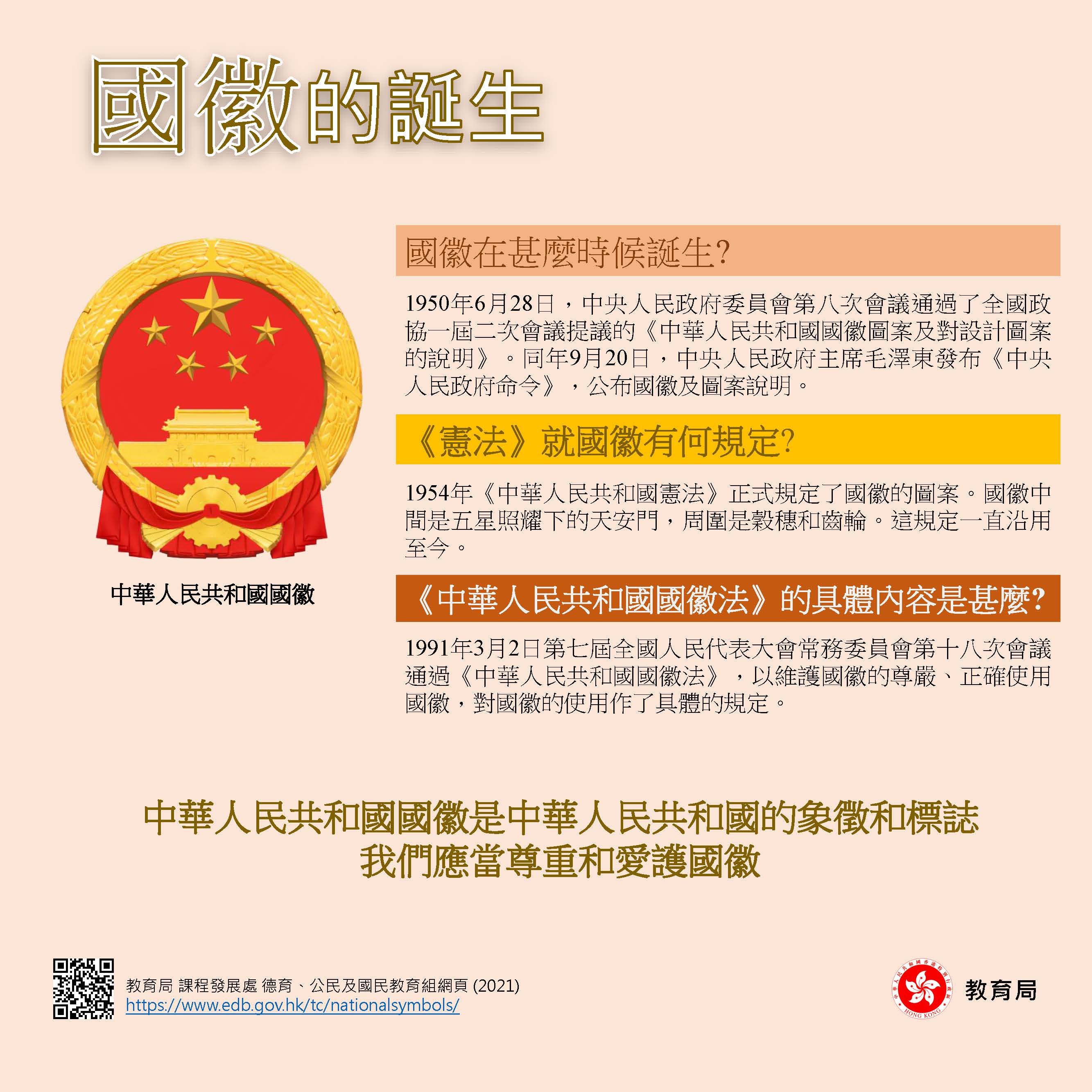
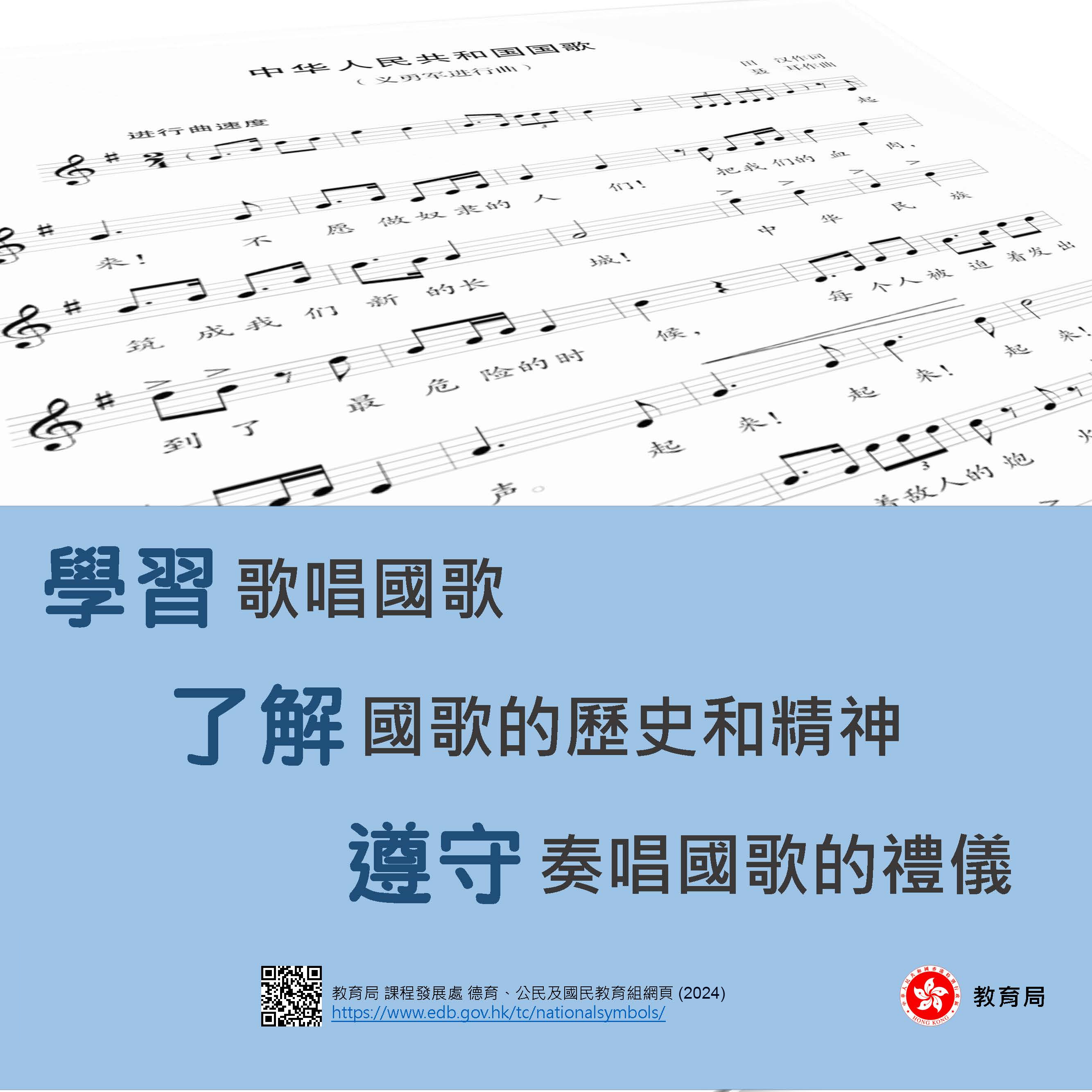
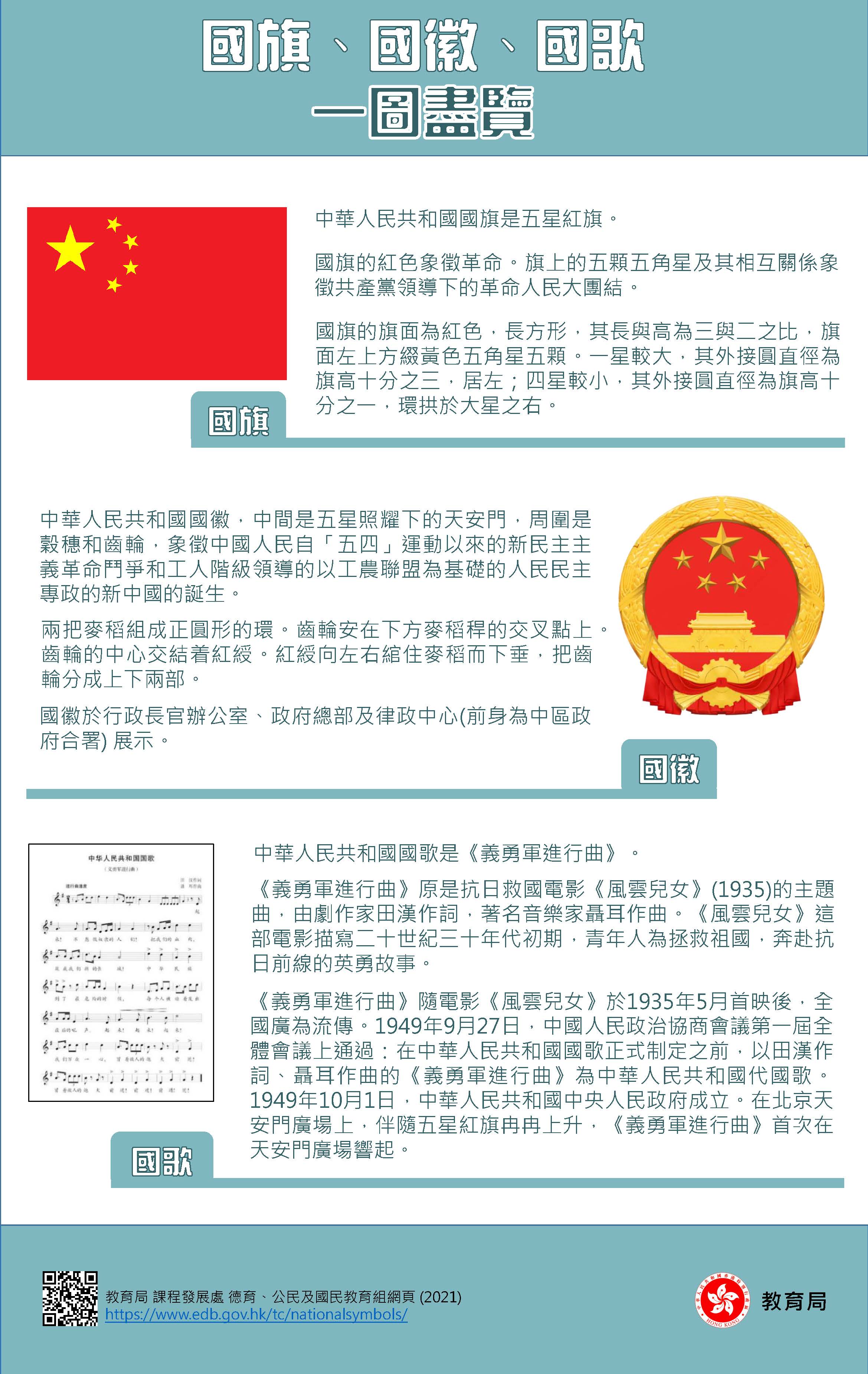
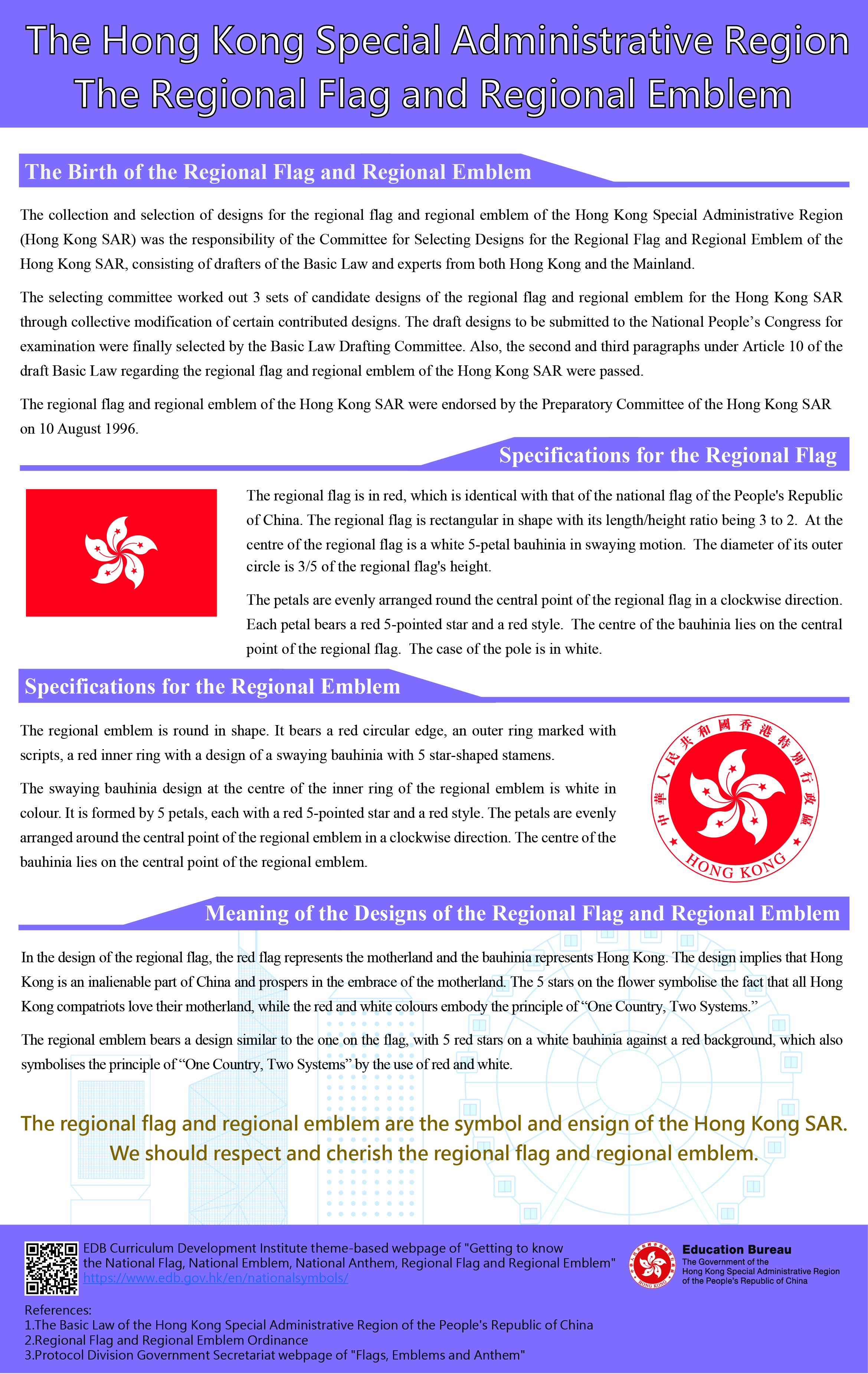
ii. “Getting to Know the National Flag, the National Emblem, the National Anthem and the Regional Flag”Online Video Series:
iii. Learning and Teaching of the National Anthem: Supplement to Arts Education Key Learning Area Music Curriculum Guide (Primary 1 to Secondary 3) (pdf)
iv. Official audio tracks of the National Anthem
v. School examples of flag raising ceremonies
vi. Others
Useful links:
National Flag
i. The Central People's Government, the People's Republic of China – National Flag
(http://big5.gov.cn/gate/big5/www.gov.cn/guoqing/2005-05/24/content_2615209.htm)
- Provides information on the history of the national flag.
ii. The Constitution of the People's Republic of China
(https://www.basiclaw.gov.hk/en/constitution/index.html)
iii. The National Flag and National Emblem Ordinance
(https://www.elegislation.gov.hk/hk/A401!en?INDEX_CS=N)
iv. The Protocol Division, Government Secretariat – Flags, Emblems and Anthem
(https://www.protocol.gov.hk/en/flags.html)
- Provides descriptions of the national flag, national emblem, national anthem, regional flag and regional emblem and their use.
National Emblem
i. The Central People's Government, the People's Republic of China – National Emblem
(http://big5.www.gov.cn/gate/big5/www.gov.cn/guoqing/guohui/index.htm)
- Provides information on the history of the national emblem.
ii. The Constitution of the People's Republic of China
(https://www.basiclaw.gov.hk/en/constitution/index.html)
iii. The National Flag and National Emblem Ordinance
(https://www.elegislation.gov.hk/hk/A401!en?INDEX_CS=N)
iv. The Protocol Division, Government Secretariat – Flags, Emblems and Anthem
(https://www.protocol.gov.hk/en/flags.html)
- Provides descriptions of the national flag, national emblem, national anthem, regional flag and regional emblem and their use.
National Anthem
i. The Central People's Government, the People's Republic of China – National Anthem
(http://english.gov.cn/audio)
- Provides information on the history, standard performance scores and official audio tracks of the national anthem.
ii. National Anthem Ordinance
(https://www.elegislation.gov.hk/hk/A405!en-zh-Hant-HK.pdf?FROMCAPINDEX=Y)
iii. The Constitutional and Mainland Affairs Bureau – National Anthem
(https://www.cmab.gov.hk/en/issues/national_anthem.htm)
- Provides relevant information on the National Anthem Ordinance as well as the standard performance scores and official audio tracks to be used on occasions on which the national anthem must be played and sung.
Regional Flag
i. The Basic Law of the Hong Kong Special Administrative Region of the People's Republic of China
(https://www.basiclaw.gov.hk/en/basiclawtext/index.html)
ii.The Regional Flag and Regional Emblem Ordinance
(https://www.elegislation.gov.hk/hk/A602!en?INDEX_CS=N)
iii. The Protocol Division, Government Secretariat – Flags, Emblems and Anthem
(https://www.protocol.gov.hk/en/flags.html)
- Provides descriptions of the national flag, national emblem, national anthem, regional flag and regional emblem and their use.
Flag raising and flag lowering ceremonies
i. The Association of Hong Kong Flag-guards
(http://ahkf.org.hk/)
- Provides information on raising the national flag in schools and points to note about flag raising.
ii. Hong Kong Army Cadets Association
(http://www.hongkongarmycadets.org/)
- Provides information on raising the national flag in schools and points to note about flag raising.
Others
i. Education Bureau – National Education One-stop Portal
(https://www.edb.gov.hk/en/neosp)
- Provides teachers and students with a one-stop solution to access the teacher professional development programmes, reading materials, video clips and online games related to Constitution, Basic Law and national security education, as well as the national flag, national emblem and national anthem.
ii. Constitutional and Mainland Affairs Bureau – The Basic Law website
(https://www.basiclaw.gov.hk/en/index/index.html)
- Provides the full text of the Basic Law as well as the related publications and multimedia information.
Back to the Top












